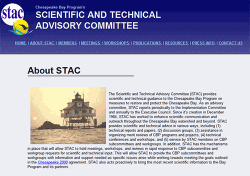Joining Chesapeake Bay Scientific and Technical Advisory Committee
Bill Dennison ·I have just joined the Chesapeake Bay Scientific and Technical Advisory Committee (STAC) as a member, but I have experience with various other review panels and STAC-type groups in various parts of the world. Thus I bring a fresh perspective, but without a deep appreciation of Chesapeake Bay STAC history and dynamics. There are some important elements of what I consider a successful STAC: 1) strong and committed leadership, 2) open and robust discussion and debate, 3) dedicated staff with strong communication skills, 4) diverse membership who contribute different elements.

Every scientific panel that I have served on has invoked an elite aspect to the selection. Not everyone is asked to serve on scientific panels, as it requires scientists with a particular expertise who can effectively communicate their thoughts as well as be receptive and thoughtful to other scientists with different backgrounds from different institutions. While this appeal can help attract good scientists, there are other aspects required to retain and engage scientists.
Since most scientific panels are not well compensated, typically only providing travel/food/accommodation reimbursement and opportunities to conduct workshops, they rely on volunteer efforts by the members. Thus, in order to effectively manage a STAC, there needs to be something compelling for the STAC members and staff to give their best efforts. The central part of making STAC activities compelling is participation in a group activity that is doing something perceived as important and valuable, not just by the members, but also by the management community that is relying on STAC for scientific advice and review. Thus, STAC needs to be providing advice directly to the highest level of decision-making. Also, STAC needs to focus on the most critical scientific issues, not on ancillary or supportive elements.
In order to draw out the best from members, it is important to consistently produce agendas with good content accompanied by adequate discussion, run meetings that abide by the designated time slots, allow for breaks and informal discussion periods to foster collegiality, and capture the essential points in accurate notes and action items. Apart from running good meetings, the other aspect needed to attract members and enhance their involvement is providing a diversity of different tasks that suit the interests and expertise of members. Finding the match between members and tasks and mentoring new members into these tasks is crucial to keeping members engaged. What does NOT work is berating members, imposing punishments or penalties, as this negative feedback just drives them away—remembering that they have 'day jobs' to attend to and the STAC activities fall typically 'above and beyond' the call of duty.
Rapid follow up from any face to face effort is helpful, as the topic is fresh and enthusiasm undiluted. Producing draft documents, distributing meeting notes, targeting action items are best done quickly—it is better to produce an unpolished draft quickly than a more polished draft slowly.
Recognizing STAC members for their contributions is also important. The senior leadership of the organization needs to express their appreciation for STAC efforts to the members. This appreciation can take many forms, but simple things like verbal acknowledgement of STAC contributions, letters of commendation upon completion of significant STAC products (e.g., reports, reviews, papers) or upon completion of the STAC member’s term, or small tokens like maps, plaques, or paperweights. Group photographs can also serve to invoke good memories.
It will be interesting, given these views on what constitutes an effective STAC, to see how the Chesapeake Bay STAC stacks up? So far, it appears to me that the Chesapeake Bay STAC has strong leadership, good staff, and a robust discussion with a diverse membership. But meetings need to be run more efficiently, positive feedbacks for members need to be developed and follow up items acted upon swiftly. STAC will need to assert themselves into the key issues facing the Chesapeake Bay Program and insure that science continues to be a central feature in the restoration of Chesapeake Bay.
About the author
Bill Dennison

Dr. Bill Dennison is a Professor of Marine Science and Vice President for Science Application at the University of Maryland Center for Environmental Science.


